Qingshan Liu
Senior Member, IEEE
TAlignDiff: Automatic Tooth Alignment assisted by Diffusion-based Transformation Learning
Aug 06, 2025Abstract:Orthodontic treatment hinges on tooth alignment, which significantly affects occlusal function, facial aesthetics, and patients' quality of life. Current deep learning approaches predominantly concentrate on predicting transformation matrices through imposing point-to-point geometric constraints for tooth alignment. Nevertheless, these matrices are likely associated with the anatomical structure of the human oral cavity and possess particular distribution characteristics that the deterministic point-to-point geometric constraints in prior work fail to capture. To address this, we introduce a new automatic tooth alignment method named TAlignDiff, which is supported by diffusion-based transformation learning. TAlignDiff comprises two main components: a primary point cloud-based regression network (PRN) and a diffusion-based transformation matrix denoising module (DTMD). Geometry-constrained losses supervise PRN learning for point cloud-level alignment. DTMD, as an auxiliary module, learns the latent distribution of transformation matrices from clinical data. We integrate point cloud-based transformation regression and diffusion-based transformation modeling into a unified framework, allowing bidirectional feedback between geometric constraints and diffusion refinement. Extensive ablation and comparative experiments demonstrate the effectiveness and superiority of our method, highlighting its potential in orthodontic treatment.
TopoDiT-3D: Topology-Aware Diffusion Transformer with Bottleneck Structure for 3D Point Cloud Generation
May 14, 2025Abstract:Recent advancements in Diffusion Transformer (DiT) models have significantly improved 3D point cloud generation. However, existing methods primarily focus on local feature extraction while overlooking global topological information, such as voids, which are crucial for maintaining shape consistency and capturing complex geometries. To address this limitation, we propose TopoDiT-3D, a Topology-Aware Diffusion Transformer with a bottleneck structure for 3D point cloud generation. Specifically, we design the bottleneck structure utilizing Perceiver Resampler, which not only offers a mode to integrate topological information extracted through persistent homology into feature learning, but also adaptively filters out redundant local features to improve training efficiency. Experimental results demonstrate that TopoDiT-3D outperforms state-of-the-art models in visual quality, diversity, and training efficiency. Furthermore, TopoDiT-3D demonstrates the importance of rich topological information for 3D point cloud generation and its synergy with conventional local feature learning. Videos and code are available at https://github.com/Zechao-Guan/TopoDiT-3D.
FauForensics: Boosting Audio-Visual Deepfake Detection with Facial Action Units
May 13, 2025Abstract:The rapid evolution of generative AI has increased the threat of realistic audio-visual deepfakes, demanding robust detection methods. Existing solutions primarily address unimodal (audio or visual) forgeries but struggle with multimodal manipulations due to inadequate handling of heterogeneous modality features and poor generalization across datasets. To this end, we propose a novel framework called FauForensics by introducing biologically invariant facial action units (FAUs), which is a quantitative descriptor of facial muscle activity linked to emotion physiology. It serves as forgery-resistant representations that reduce domain dependency while capturing subtle dynamics often disrupted in synthetic content. Besides, instead of comparing entire video clips as in prior works, our method computes fine-grained frame-wise audiovisual similarities via a dedicated fusion module augmented with learnable cross-modal queries. It dynamically aligns temporal-spatial lip-audio relationships while mitigating multi-modal feature heterogeneity issues. Experiments on FakeAVCeleb and LAV-DF show state-of-the-art (SOTA) performance and superior cross-dataset generalizability with up to an average of 4.83\% than existing methods.
ProgRoCC: A Progressive Approach to Rough Crowd Counting
Apr 18, 2025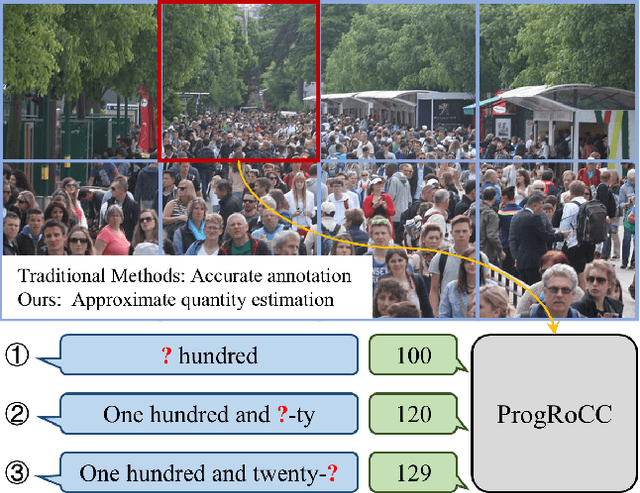
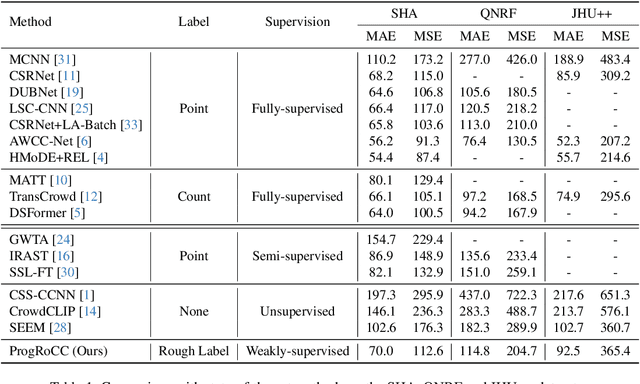
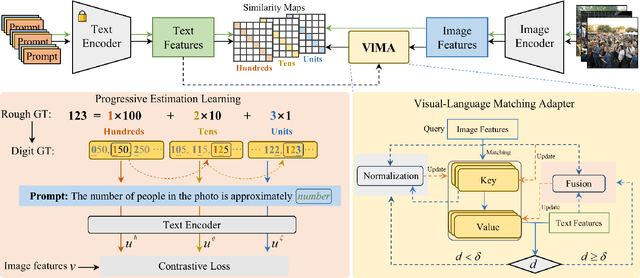

Abstract:As the number of individuals in a crowd grows, enumeration-based techniques become increasingly infeasible and their estimates increasingly unreliable. We propose instead an estimation-based version of the problem: we label Rough Crowd Counting that delivers better accuracy on the basis of training data that is easier to acquire. Rough crowd counting requires only rough annotations of the number of targets in an image, instead of the more traditional, and far more expensive, per-target annotations. We propose an approach to the rough crowd counting problem based on CLIP, termed ProgRoCC. Specifically, we introduce a progressive estimation learning strategy that determines the object count through a coarse-to-fine approach. This approach delivers answers quickly, outperforms the state-of-the-art in semi- and weakly-supervised crowd counting. In addition, we design a vision-language matching adapter that optimizes key-value pairs by mining effective matches of two modalities to refine the visual features, thereby improving the final performance. Extensive experimental results on three widely adopted crowd counting datasets demonstrate the effectiveness of our method.
SuperFlow++: Enhanced Spatiotemporal Consistency for Cross-Modal Data Pretraining
Mar 25, 2025Abstract:LiDAR representation learning has emerged as a promising approach to reducing reliance on costly and labor-intensive human annotations. While existing methods primarily focus on spatial alignment between LiDAR and camera sensors, they often overlook the temporal dynamics critical for capturing motion and scene continuity in driving scenarios. To address this limitation, we propose SuperFlow++, a novel framework that integrates spatiotemporal cues in both pretraining and downstream tasks using consecutive LiDAR-camera pairs. SuperFlow++ introduces four key components: (1) a view consistency alignment module to unify semantic information across camera views, (2) a dense-to-sparse consistency regularization mechanism to enhance feature robustness across varying point cloud densities, (3) a flow-based contrastive learning approach that models temporal relationships for improved scene understanding, and (4) a temporal voting strategy that propagates semantic information across LiDAR scans to improve prediction consistency. Extensive evaluations on 11 heterogeneous LiDAR datasets demonstrate that SuperFlow++ outperforms state-of-the-art methods across diverse tasks and driving conditions. Furthermore, by scaling both 2D and 3D backbones during pretraining, we uncover emergent properties that provide deeper insights into developing scalable 3D foundation models. With strong generalizability and computational efficiency, SuperFlow++ establishes a new benchmark for data-efficient LiDAR-based perception in autonomous driving. The code is publicly available at https://github.com/Xiangxu-0103/SuperFlow
LiMoE: Mixture of LiDAR Representation Learners from Automotive Scenes
Jan 07, 2025Abstract:LiDAR data pretraining offers a promising approach to leveraging large-scale, readily available datasets for enhanced data utilization. However, existing methods predominantly focus on sparse voxel representation, overlooking the complementary attributes provided by other LiDAR representations. In this work, we propose LiMoE, a framework that integrates the Mixture of Experts (MoE) paradigm into LiDAR data representation learning to synergistically combine multiple representations, such as range images, sparse voxels, and raw points. Our approach consists of three stages: i) Image-to-LiDAR Pretraining, which transfers prior knowledge from images to point clouds across different representations; ii) Contrastive Mixture Learning (CML), which uses MoE to adaptively activate relevant attributes from each representation and distills these mixed features into a unified 3D network; iii) Semantic Mixture Supervision (SMS), which combines semantic logits from multiple representations to boost downstream segmentation performance. Extensive experiments across 11 large-scale LiDAR datasets demonstrate our effectiveness and superiority. The code and model checkpoints have been made publicly accessible.
4D Contrastive Superflows are Dense 3D Representation Learners
Jul 10, 2024



Abstract:In the realm of autonomous driving, accurate 3D perception is the foundation. However, developing such models relies on extensive human annotations -- a process that is both costly and labor-intensive. To address this challenge from a data representation learning perspective, we introduce SuperFlow, a novel framework designed to harness consecutive LiDAR-camera pairs for establishing spatiotemporal pretraining objectives. SuperFlow stands out by integrating two key designs: 1) a dense-to-sparse consistency regularization, which promotes insensitivity to point cloud density variations during feature learning, and 2) a flow-based contrastive learning module, carefully crafted to extract meaningful temporal cues from readily available sensor calibrations. To further boost learning efficiency, we incorporate a plug-and-play view consistency module that enhances the alignment of the knowledge distilled from camera views. Extensive comparative and ablation studies across 11 heterogeneous LiDAR datasets validate our effectiveness and superiority. Additionally, we observe several interesting emerging properties by scaling up the 2D and 3D backbones during pretraining, shedding light on the future research of 3D foundation models for LiDAR-based perception.
Cooperative Sentiment Agents for Multimodal Sentiment Analysis
Apr 19, 2024Abstract:In this paper, we propose a new Multimodal Representation Learning (MRL) method for Multimodal Sentiment Analysis (MSA), which facilitates the adaptive interaction between modalities through Cooperative Sentiment Agents, named Co-SA. Co-SA comprises two critical components: the Sentiment Agents Establishment (SAE) phase and the Sentiment Agents Cooperation (SAC) phase. During the SAE phase, each sentiment agent deals with an unimodal signal and highlights explicit dynamic sentiment variations within the modality via the Modality-Sentiment Disentanglement (MSD) and Deep Phase Space Reconstruction (DPSR) modules. Subsequently, in the SAC phase, Co-SA meticulously designs task-specific interaction mechanisms for sentiment agents so that coordinating multimodal signals to learn the joint representation. Specifically, Co-SA equips an independent policy model for each sentiment agent that captures significant properties within the modality. These policies are optimized mutually through the unified reward adaptive to downstream tasks. Benefitting from the rewarding mechanism, Co-SA transcends the limitation of pre-defined fusion modes and adaptively captures unimodal properties for MRL in the multimodal interaction setting. To demonstrate the effectiveness of Co-SA, we apply it to address Multimodal Sentiment Analysis (MSA) and Multimodal Emotion Recognition (MER) tasks. Our comprehensive experimental results demonstrate that Co-SA excels at discovering diverse cross-modal features, encompassing both common and complementary aspects. The code can be available at https://github.com/smwanghhh/Co-SA.
Defenses in Adversarial Machine Learning: A Survey
Dec 13, 2023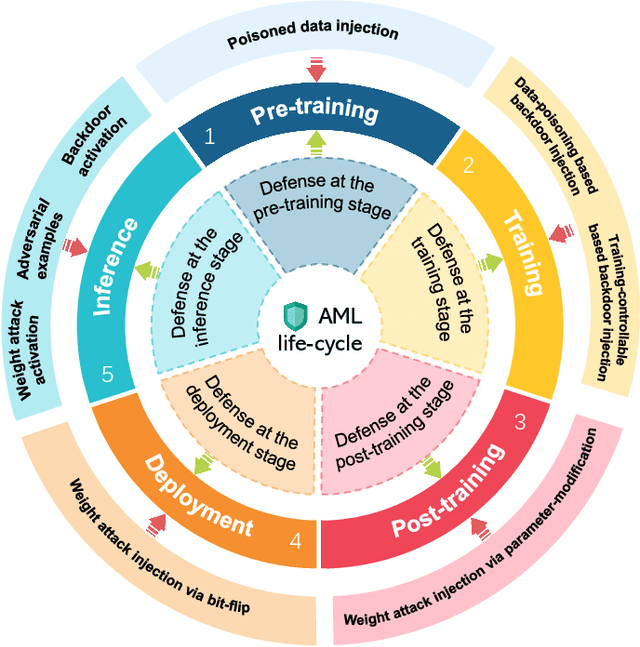
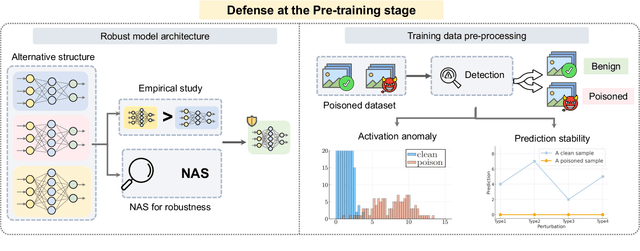
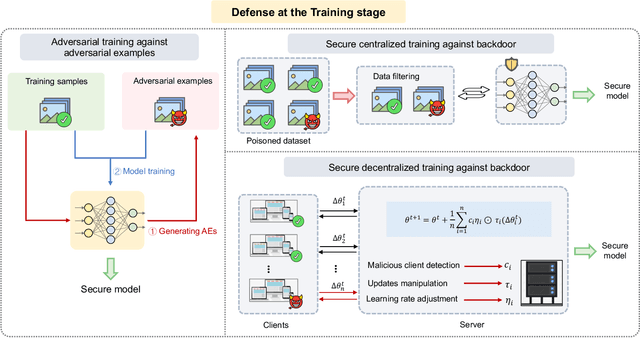

Abstract:Adversarial phenomenon has been widely observed in machine learning (ML) systems, especially in those using deep neural networks, describing that ML systems may produce inconsistent and incomprehensible predictions with humans at some particular cases. This phenomenon poses a serious security threat to the practical application of ML systems, and several advanced attack paradigms have been developed to explore it, mainly including backdoor attacks, weight attacks, and adversarial examples. For each individual attack paradigm, various defense paradigms have been developed to improve the model robustness against the corresponding attack paradigm. However, due to the independence and diversity of these defense paradigms, it is difficult to examine the overall robustness of an ML system against different kinds of attacks.This survey aims to build a systematic review of all existing defense paradigms from a unified perspective. Specifically, from the life-cycle perspective, we factorize a complete machine learning system into five stages, including pre-training, training, post-training, deployment, and inference stages, respectively. Then, we present a clear taxonomy to categorize and review representative defense methods at each individual stage. The unified perspective and presented taxonomies not only facilitate the analysis of the mechanism of each defense paradigm but also help us to understand connections and differences among different defense paradigms, which may inspire future research to develop more advanced, comprehensive defenses.
FRNet: Frustum-Range Networks for Scalable LiDAR Segmentation
Dec 07, 2023Abstract:LiDAR segmentation is crucial for autonomous driving systems. The recent range-view approaches are promising for real-time processing. However, they suffer inevitably from corrupted contextual information and rely heavily on post-processing techniques for prediction refinement. In this work, we propose a simple yet powerful FRNet that restores the contextual information of the range image pixels with corresponding frustum LiDAR points. Firstly, a frustum feature encoder module is used to extract per-point features within the frustum region, which preserves scene consistency and is crucial for point-level predictions. Next, a frustum-point fusion module is introduced to update per-point features hierarchically, which enables each point to extract more surrounding information via the frustum features. Finally, a head fusion module is used to fuse features at different levels for final semantic prediction. Extensive experiments on four popular LiDAR segmentation benchmarks under various task setups demonstrate our superiority. FRNet achieves competitive performance while maintaining high efficiency. The code is publicly available.
 Add to Chrome
Add to Chrome Add to Firefox
Add to Firefox Add to Edge
Add to Edge